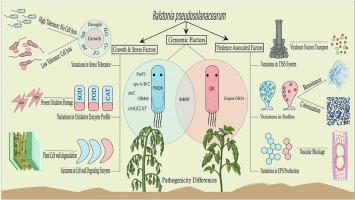Strain-specific virulence and stress adaptation in Ralstonia pseudosolanacearum: Implications for bacterial wilt diagnostics and control
IF 3.3
3区 农林科学
Q2 PLANT SCIENCES
引用次数: 0
Abstract
Ralstonia pseudosolanacearum, a major phytopathogen within the R. solanacearum species complex, causes bacterial wilt in a wide range of crops and exhibits strain-specific differences in virulence and environmental resilience, posing significant challenges for disease management. This study compared two closely related strains, QK and YNQK, both classified as phylotype I, biovar III, but differing markedly in pathogenicity and stress tolerance. Pathogenicity assay revealed that YNQK exhibits significantly higher pathogenicity in Nicotiana benthamiana, causing severe wilting, whereas QK-infected plants remained largely asymptomatic. Strain YNQK exhibited higher resistance to stresses of acid (pH 5.0), alkali (pH 9.5), drought (PEG6000 > 20 %), 45 mM H2O2, and 1000 mg/L Cd2+, while strain QK showed lower tolerance under similar conditions. Under drought stress, strain YNQK produced more exopolysaccharides (89.70 μg/mL) than QK (65.67 μg/mL), and under H2O2 stress, it exhibited higher biofilm production and antioxidant enzyme activity. Comparative genomics revealed that strain YNQK uniquely holds key genes, including PopF2 (pathogenic), chrC (chromate resistance), and cnrA, B, C, H, Y (cobalt and nickel resistances). Both strains shared core osmotic stress-related genes involved in K+ transport (kup), proline and betaine biosynthesis (proA/B/C, betA/B, gbsA), and biofilm formation (eps, pga, rfb clusters). These findings highlight the role of genetic variation in shaping strain-specific virulence and abiotic stress tolerance in R. pseudosolanacearum. While the pathogenicity assays in this study relied on leaf infiltration rather than natural root infection, which may bypass early host defenses, the results nonetheless provide valuable insight into strain-level differences and inform the development of more precise diagnostic and management strategies.

菌株特异性毒力和胁迫适应性:对青枯病诊断和控制的意义
假solanacearum (Ralstonia pseudosolanacearum)是solanacearum属植物群中的一种主要病原菌,可在多种作物中引起细菌性枯萎病,并在毒力和环境适应能力方面表现出菌株特异性差异,对病害管理提出了重大挑战。本研究比较了两个密切相关的菌株,QK和YNQK,它们都被分类为I种型,生物变种III,但在致病性和耐受性上有明显差异。致病性分析表明,YNQK对本烟的致病性显著提高,可引起严重的萎蔫,而qk侵染植株基本无症状。菌株YNQK对酸(pH 5.0)、碱(pH 9.5)、干旱(PEG6000 > 20%)、45 mM H2O2和1000 mg/L Cd2+的耐受性较高,而菌株QK在相同条件下的耐受性较低。干旱胁迫下,YNQK的胞外多糖产量(89.70 μg/mL)高于QK (65.67 μg/mL), H2O2胁迫下YNQK的生物膜产量和抗氧化酶活性均高于QK。比较基因组学显示,菌株YNQK具有独特的关键基因,包括致病基因PopF2、抗铬酸盐基因chrC和抗钴镍基因cnrA、B、C、H、Y。这两种菌株都具有渗透胁迫相关的核心基因,这些基因涉及K+转运(kup)、脯氨酸和甜菜碱生物合成(proA/B/C、betA/B、gbsA)和生物膜形成(eps、pga、rfb簇)。这些发现强调了遗传变异在形成假茄青霉菌株特异性毒力和非生物胁迫耐受性中的作用。虽然本研究中的致病性测定依赖于叶片渗透而不是自然根感染,这可能绕过早期宿主防御,但结果仍然为菌株水平差异提供了有价值的见解,并为更精确的诊断和管理策略的发展提供了信息。
本文章由计算机程序翻译,如有差异,请以英文原文为准。
求助全文
约1分钟内获得全文
求助全文
来源期刊
CiteScore
4.30
自引率
7.40%
发文量
130
审稿时长
38 days
期刊介绍:
Physiological and Molecular Plant Pathology provides an International forum for original research papers, reviews, and commentaries on all aspects of the molecular biology, biochemistry, physiology, histology and cytology, genetics and evolution of plant-microbe interactions.
Papers on all kinds of infective pathogen, including viruses, prokaryotes, fungi, and nematodes, as well as mutualistic organisms such as Rhizobium and mycorrhyzal fungi, are acceptable as long as they have a bearing on the interaction between pathogen and plant.

 求助内容:
求助内容: 应助结果提醒方式:
应助结果提醒方式:


